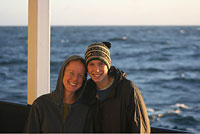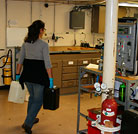

 | |||||||||||||||||||||
|
|
Journals 2008/2009Jeff Lawrence
December 13, 2008 As I scan all around us, all that can be seen for as far as the eye can see is water. Why then is it rationed for the scientists aboard when they attain fresh samples from the CTD? The CTD has twelve bottles that collect samples of seawater in the bottles deployed around its outer perimeter, which is called the rosette. Each bottle holds 30 liters of fresh salt water and each scientist is vying for some of that water to do their lab experiments. There is only enough water to go around if everyone conserves and uses only what they absolutely need, not necessarily what they want. A person who is identified as the "water police" will stand next to the rosette and he/she makes sure that the water is given to those individuals who have signed up for a portion, in the amount they need, and in a sequential order. The water in each bottle is from a different depth in the ocean so there is a very limited supply at some depths, which depends on the number of bottles filled at a specific depth. I have helped deploy the CTD many times and have seen it collect samples from as deep as 5200 meters and as shallow as one meter. During the noon to midnight shift one of my duties is to cock the bottles on the CTD and prepare it for a station sample. When this task is complete it is ferried out on deck where I and another person use taglines to secure it over the starboard side of the boat. The CTD can be underwater for up to four hours or longer, or simply 30 minutes depending on the depth it is deployed. When it has collected it samples it is brought back onboard, two people snag it with an 18'pole that has a rope and a hook on the end. This can be quick and easy when the water is calm, however if the ship is listing it can be difficult to snag and hard to control as it is brought on board the ship. Matt Durham is the Res-Tech on duty with me and he ensures that everything is done correctly and more importantly safely. Then the samples are parceled out to the scientist onboard. Emily Lyskowski acts as the water police this shift and I collect eight two-liter samples of water from a specified eight bottles off the CTD. Then the water sampling begins.
Work on board a research vessel can mean long shifts and ever growing weary laborers. Even though we are on twelve-hour shifts, many times you work more than those twelve hours. My shift begins at noon and ends at midnight, however since I send in a journal entry everyday, take pictures, and visit with the scientist and crew aboard the REVELLE, my day may start as early as 7:00 am. You can see some the work may be a little strenuous and definitely tiring. The life of a research scientist while at sea is not filled with glamour, although they seem to get really excited when they find what they are looking for and sometimes what they are not looking for. The ship runs 24/7 and is constantly collecting data for scientist to investigate while they are aboard and later when they return to their labs.
Questions of the day:
|
||||||||||||||||||||




